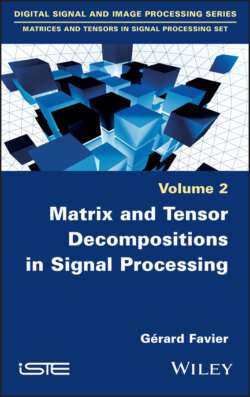Читать книгу Matrix and Tensor Decompositions in Signal Processing - Gérard Favier - Страница 4
List of Tables
Оглавление1 IntroductionTable I.1. Signal and image tensorsTable I.2. Other fields of applicationTable I.3. Parametric complexity of the CPD, TD, and TT decompositionsTable I.4. Cost functions for model estimation and recovery of missing data
2 Chapter 1Table 1.1. The most common matrix decompositionsTable 1.2. Eigenvalues of a real square matrixTable 1.3. Eigenvalues and extrema of the Rayleigh quotientTable 1.4. Eigenvalue properties of certain matrix classesTable 1.5. Eigenvalues of positive/negative (semi-)definite matricesTable 1.6. Equivalent and similar matricesTable 1.7. Fundamental subspaces of A ∈ I×JTable 1.8. Relations between the fundamental subspacesTable 1.9. Relations between left and right singular vectorsTable 1.10. Definition and properties of the SVDTable 1.11. Relations between the left and right singular vectorsTable 1.12. SVD and fundamental subspacesTable 1.13. Computation of an SVD and of the Moore-Penrose pseudo-inverseTable 1.14. Matrix normsTable 1.15. Rank-k approximation and approximation errorsTable 1.16. Least squares estimator
3 Chapter 2Table 2.1. Hadamard, Kronecker, and Khatri-Rao products and Kronecker sumTable 2.2. Hadamard product of Hermitian positive (semi-)definite matricesTable 2.3. Basic relations satisfied by the Hadamard productTable 2.4. The diag operator and the Hadamard productTable 2.5. Basic relations satisfied by the Kronecker product of vectorsTable 2.6. Rank-one matrices and Kronecker products of vectorsTable 2.7. Other decompositions of (u ⊗ v)(x ⊗ y)HTable 2.8. Relations involving Kronecker products of vectorsTable 2.9. Properties of the multiple Kronecker productTable 2.10. Identities involving matrix-vector Kronecker productsTable 2.11. Rank, trace, determinant, and spectrum of a Kronecker productTable 2.12. Kronecker product of positive/negative definite matricesTable 2.13. Structural properties of the Kronecker productTable 2.14. Kronecker products of vectors and index conventionTable 2.15. Kronecker products of matrices and index conventionTable 2.16. Commutation matrices, vectorization, and Kronecker productTable 2.17. Khatri-Rao product and index conventionTable 2.18. Relations between the Hadamard, Khatri-Rao, and Kronecker productsTable 2.19. Relations between the Kronecker, Khatri-Rao, and Hadamard products o...Table 2.20. Other relations between the Kronecker, Khatri-Rao, and Hadamard prod...Table 2.21. Basic relationsTable 2.22. Vectorization formulaeTable 2.23. Partial derivatives of various functionsTable 2.24. Derivatives of a scalar function and a vector functionTable 2.25. Derivatives of a matrix function with respect to a matrix variableTable 2.26. Definitions of in partitioned formTable 2.27. Other derivativesTable 2.28. Derivatives of matrix traces
4 Chapter 3Table 3.1. Notation for sets of indices and dimensionsTable 3.2. Various sets of tensorsTable 3.3. Multilinear forms and associated tensorsTable 3.4. Multilinear forms and associated homogeneous polynomialsTable 3.5. Notation for tensorsTable 3.6. Matricization by index blocks for different sets of tensorsTable 3.7. Block-wise transposition Table 3.8. Hermitian/symmetric tensors by blocks of order PTable 3.9. Block symmetrized tensor χ of a third-order tensor Table 3.10. Outer products of matrices and tensorsTable 3.11. Scalar elements of outer productsTable 3.12. Matricized and vectorized forms of a rank-one third-order tensorTable 3.13. Mode-p products of a third-order tensor with a matrixTable 3.14. Matrix products and mode-p productTable 3.15. Different types of multiplication with tensorsTable 3.16. Orthogonality and idempotence propertiesTable 3.17. Inverses of orthogonal/unitary tensorsTable 3.18. Generalized inversesTable 3.19. Operations with the Einstein productTable 3.20. Properties of the Moore-Penrose pseudo-inverseTable 3.21. LS solutions of tensor linear systemsTable 3.22. Matrix operationsTable 3.23. Tensor operations
5 Chapter 4Table 4.1. Eigenpairs and generalized eigenpairs for tensorsTable 4.2. Properties of hypercubic symmetric tensors
6 Chapter 5Table 5.1. Third-order Tucker modelTable 5.2. Tucker-(2,3) and Tucker-(1,3) modelsTable 5.3. Third-order PARAFAC modelTable 5.4. Fourth-order PARAFAC modelTable 5.5. Variants of the third-order PARAFAC modelTable 5.6. k-rank of certain matrices and essential uniqueness of a third-order ...
7 Appendix Random Variables and Stochastic ProcessesTable A1.1. Some definitions for jointly distributed r.v.s x and yTable A1.2. Definitions of uncorrelated and orthogonal r.v.s x and yTable A1.3. Properties of r.v.sTable A1.4. Definitions and properties of the second-order statistics of real ra...Table A1.5. Definitions and properties for real random signals x(k) and y(k)Table A1.6. Definitions and properties of second-order statistics for stationary...Table A1.7. Second-order statistics of the output of a linear systemTable A1.8. Factors of the polyspectraTable A1.9. Bispectra and trispectra of the output of a linear system
